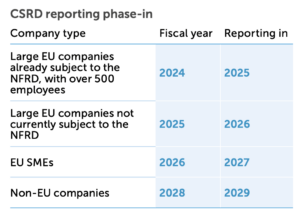New EU sustainability reporting – the facts

This year is the first time that some companies will need to comply with new EU rules as part of the European Green Deal. We explain some of the ins and outs.
In 2024, there will be a significant transformation in corporate sustainability reporting in the EU and subsequently worldwide. As of the new fiscal year, companies falling within the scope of the directive will be required to disclose their Environmental, Social and Governance (ESG) impacts under the Corporate Sustainability Reporting Directive (CSRD).
Decoding the terminology
CSRD
The CSRD represents a comprehensive revision of the 2014 Non-Financial Reporting Directive (NFRD), the existing EU sustainability framework. Its objective is to enhance data quality for investors, while aligning with the policy objectives of the Green Deal.
ESRS
If you are already familiar with the new directive, you might also be aware of the European Sustainability Reporting Standards (ESRS). These standards lay out the reporting requirements of the CSRD. The ESRS consists of 2 ‘cross-cutting’ standards composed of general requirements, plus 10 additional standards that are specific to any of ‘E’ (environment), ‘S’ (social) or ‘G’ (governance) topics.
The European Commission recently proposed some changes to the ESRS, allowing companies with less than 700 employees to omit Scope 3*** and own workforce disclosures during the first year. The Disclosure Requirements in ESRS 2 – which address cross-cutting general disclosures – are to be reported irrespective of the outcome of the assessment, and all other ESRSs are subject to materiality assessments.
Key CSRD features and requirements
Double materiality
Double materiality requires companies to report on both the financial risks sustainability issues may pose to their business (= financial materiality) and the company’s impacts on people and the environment (= impact materiality). The CSRD is the first major legislation that requires a double materiality approach to all ESRS standards.
Cross-cutting disclosures
Two cross-cutting standards cover overarching reporting requirements on governance, strategy, impacts, risks and opportunities, as well as metrics and targets. These are tightly aligned with recommendations from the Task Force on Climate-Related Financial Disclosures. Disclosure requirements include:
- Material ESG risks, opportunities and impacts (operational and across the value chain)
- Impact of risks and opportunities on the business model
- Sustainability due diligence processes
- Risk management processes, board oversight, integration of sustainability KPIs into incentivization schemes
- Policies to manage material ESG impacts
- Sustainability targets, goals and metrics
- Action plans for addressing material ESG topics
Reporting across a broad range of topics
On top of the mandatory cross-cutting disclosures listed above, the CSRD also requires disclosures on material impacts, risks and opportunities across various ESG topics. Although these are technically subject to double materiality, it is highly unlikely that more than a few (if any) can be omitted. For example, subjects like climate change, biodiversity, own workforce, workers in the value chain, and affected communities apply to almost all businesses.
CSRD expands scope
Besides the need for more comprehensive reporting on environmental and human rights impacts and sustainability-related risks, the CSRD significantly expands the number of companies within its scope, from approximately 12,000 to over 50,000. Businesses that come under the scope of the CSRD will also have to disclose their company’s percentage of turnover, revenue and capital expenditures aligned with the 6 EU taxonomy objectives.
Who’s impacted by the CSRD?
The new sustainability directive impacts 3 groups of companies:
- Large companies based in the EU – with at least 2 of the following: over 250 employees, over €40 million ($43.7M) turnover in net revenue or over €20 million ($21.9M) total balance sheet assets
- EU small and medium enterprises (SMEs) – with less than 250 employees, less than €40 million ($43.7M) turnover and less than €20 million ($21.9M) total assets
- Certain non-EU parent companies doing business in the EU – with €150 million ($164M) net turnover in the region and 1 branch or subsidiary in the EU generating more than €40 million ($43.7M) net turnover
6 steps to prepare
The CSRD reporting requirements for different types of companies will be phased in between 2025 and 2029. For some businesses, the disclosure timeframe may seem far away, but many of the steps to comply with the standards require years of planning and implementation.
1. Set up a cross-departmental working group: to collect the information needed for CSRD compliance and to integrate ESG aspects into standard business functions. This includes, but is not limited to, risk, legal, procurement and finance.
Achieving integration is not feasible with a siloed ESG department, particularly when it concerns nuanced ESRS topics such as biodiversity, the circular economy and value chain workers. Companies that do not meet the requirements of the CSRD may be those that fail to integrate ESG efforts across all their departments. It’s worth noting that the expectations of the CSRD surpass what ESG teams – or even diversity, equity, inclusion and justice teams – can achieve independently.
2. Conduct a double materiality assessment: using the 12 ESRS as a guide, conduct an assessment to determine which ESG topics financially impact your business and how your business impacts those issues.
3. Create a climate transition plan: part of the climate change disclosure is a 1.5°C-aligned transition plan. How to reduce significant Scope 1* and 2** emission sources, including fuel and energy use, is what needs to be considered. Assess whether your business model – or a part of it – needs to change to support a net-zero economy. Developing a plan means engaging business leaders from the cross-departmental working group and determining possible strategies – an all-hands-on-deck effort is required.
4. Build a strategy for Scope 3 emissions: the CSRD requires Scope 3*** disclosure for all in-scope companies. To develop a Scope 3 strategy, start by communicating expectations and data reporting requirements to your suppliers. It is advisable to use a supplier management platform like CDP Supply Chain or EcoVadis to track progress.
Establishing effective reporting processes with your suppliers can take years, before you can even start implementing a Scope 3 reduction plan, so this is not an area to procrastinate in. And by the time CSRD reporting applies to all companies, the 2030 greenhouse gas emissions goals will be just a year away.
5. Educate your board on sustainability: for effective management of risks and opportunities, the board should oversee sustainability issues. Educate the board on sustainability and adopt a governance structure that meaningfully incorporates board and executive oversight. This includes screening board members for ESG topic competence.
6. Engage an assurance provider: independent third- party assurance is mandatory from 2025. So, if an assurance provider has not already been engaged, initiate the process now to obtain their advice upfront. Make sure all expectations are clear and develop programs and disclosures accordingly. At a minimum, a clear audit trail and documentation of all processes and controls are necessary to support disclosures.
Rising investor expectations
As with several recent ESG policies in the EU, the CSRD carries extensive implications. Even if your business is not officially within the CSRD scope, it is wise to stay ahead of developments. Frameworks and regulations emerging from the EU traditionally indicate the direction of global trends in ESG and corporate accountability. Also, investor expectations are anticipated to rise continuously. The capacity to produce auditable ESG reports with investor- ready information is critical, irrespective of legal requirements.


